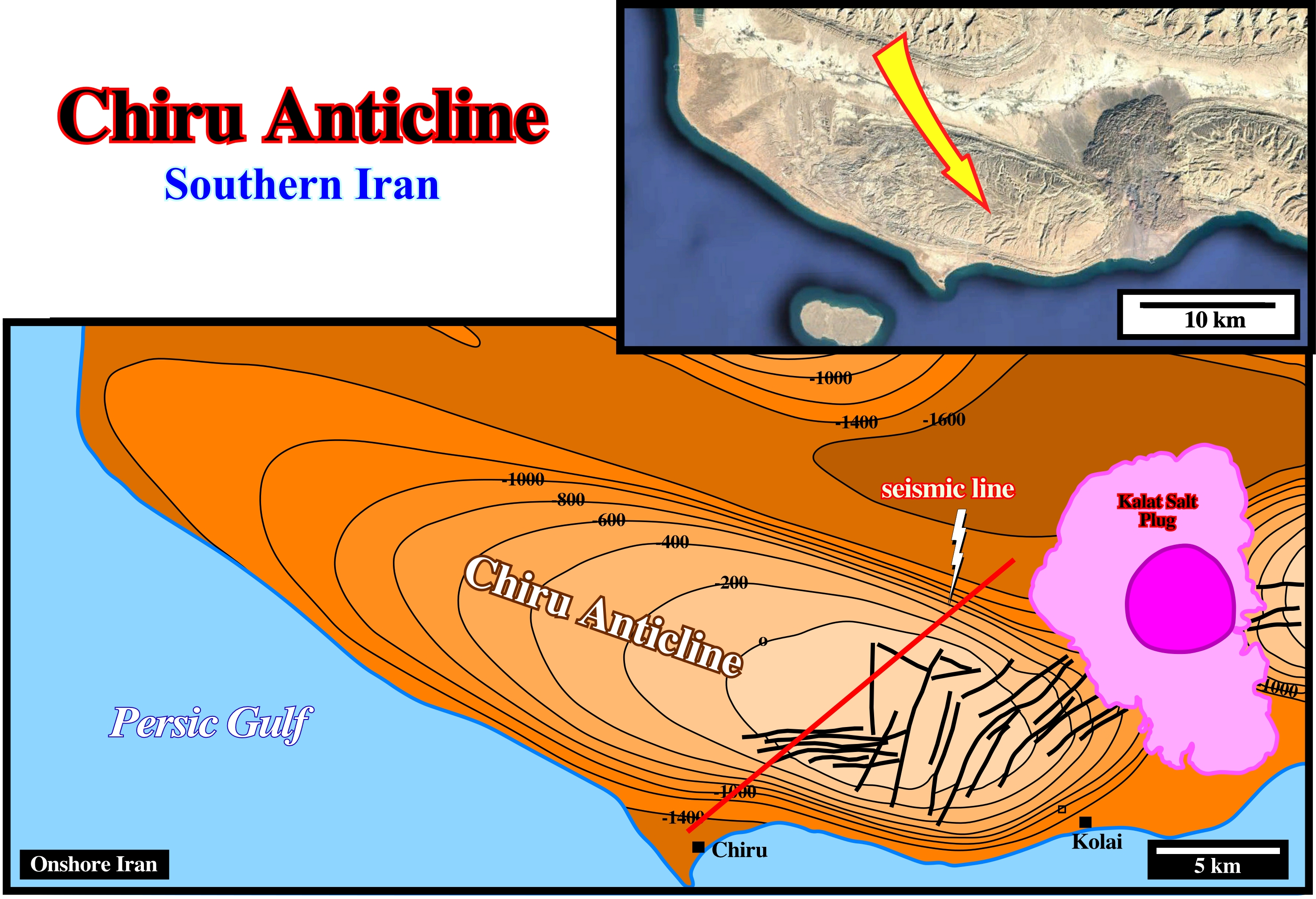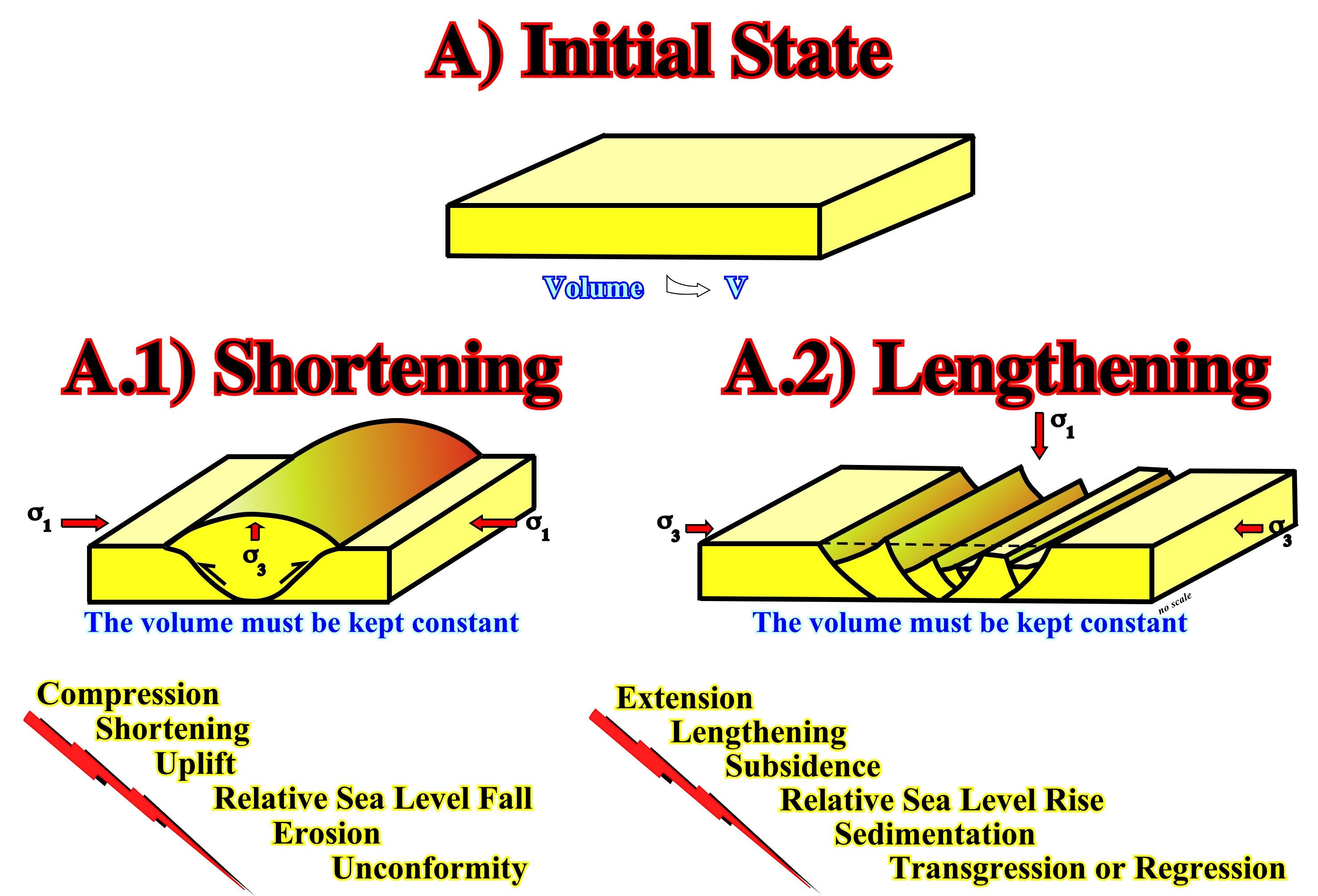

16) Sedimentary Shortening & Lengthening
The first step in a tentative geological interpretations of a seismic line is to decide if the sediments are shortened or lengthened. A bad decision leads, necessarily, to a wrong tentative interpretation, because the geoscientist will be looking for geological events that are not present on the seismic line.
Sediments can be lengthened or shortened. During a compressional tectonic regime (σ1 horizontal, that is to say when maximum effective stress is horizontal) the sediments are shortened and so be uplifted. The uplift creates a relative sea level fall, i.e., an erosional surface (unconformity). Do not forget that what deforms the sediments are the effective stress, i.e., the combination of the geostactic pressure (σg), pore pressure or hydrostatic pressure (σp) and the tectonic stress (σt) and not the tectonic stress (σ1) alone as lot of geoscientists think. That means that the sediments can be shortened with a tectonic stress (σt) positive. That is the reason why is more correct to speak in shortening and lengthening than in compression and extension.
Consequently, we can say:
σ1 horizontal......Shortening
Shortening......Uplift
Uplift......Relative Sea Level Fall
Relative Sea Level Fall......Erosional Surface
Erosional Surface......Unconformity
Unconformity......New Sequence-Cycle
New Sequence-Cycle......Basin Floor Fan
The shortening takes place along σ1 (perpendicularly to the axes of the folds), but some lengthening can be seen along σ2. In fact, in Jura Mountains, Wegmann (1954) recognised that the anticline structures were elongated along their axes (σ2) by relatively small strike slip faults, which do not occur in the synclines. Since then, these particular strike-slip faults have been recognised in the majority of the fold-belt (figure 071).

Figure 071- The Chiru anticline is illustrated by a composite map built with surface and seismic data. The elongation the Chiru anticline along the σ2 is quite evident on this geological map. Small compressional strike-slip faults are recognized near the top of the anticline. They elongated the anticline along its axis, i.e. along the middle effective stress (σ2). These faults are not recognized in the anticline flanks or the syncline axis. In spite of the fact that they affect several beds, sometimes, unskilled geologists erroneously interpret them as “extrados” fractures. The vertical conjugated faults, which elongate it, show, in the field, clear horizontal slickensides, therefore they are strike-slip faults and not normal faults. In other words, as said previous, during a compressional tectonic regime, it is impossible to develop normal faults in the apexes of anticlines (sediments cannot be shortened and lengthened at same time in same place). However, very often, seismic interpreters, wrongly, consider such a strike-slip faults as normal faults (there are not vertical normal faults, they are a physical impossibility). “Extrados fractures” are only developed within a sedimentary bed, above (extensional) and below (compressional) the neutral surface. Indeed, as pointed out by Price (1990), in tangential longitudinal strain folds, the maximum strain occurs at the hinge and no strain occurs at the inflexion point. As its name implies, in this type of folding, one of the principal strains is always parallel (tangential) to the boundary layer. The outer arc of the hinge area (extrados) experiences an extension and the maximum principal extension is parallel to the boundary layer. Conversely, the inner arc (intrados) is compressed and the minimum principal extension is parallel to the boundary layer. A line along which there is no strain separates these two states of strain. This surface is called the neutral surface. It separates an area of layer-parallel compression from one of layer-parallel extension.

Figure 072- Here, the Chiru anticline is illustrated by the interpretation of a strike seismic line, that is to say, a seismic line shot parallel to the maximum effective stress (σ1) of the tectonic regime responsible for the deformation. In other words, the seismic line is perpendicular to the axis of the anticline, which is parallel to σ2. The location of the line is shown in red in Figure 063. As depicted, the sediments were shortened and uplifted by folding and faulting. The σ1 of the stress ellipsoid responsible for the deformation was horizontal striking N 20-30° (as suggested by the structural contour map in Figure 063. Under such tectonic conditions the development of normal faults is unlikely. Normal faults are created when σ1 is vertical (extensional tectonic regime). In fact, the faults, recognized on the line, are clearly reverse faults. The fault planes dip towards the up-thrown faulted block (hangingwall). The compressional strike slip faults, recognized on the field, elongating the structure along its axis, near the apex of the anticline, are too small to be materialized on the seismic line. The magnitude of their thrown is under seismic resolution. At this point, it is interesting to call attention to the fact that the tectonic stress (σt) is not responsible for the deformation of the sediments. The sediments are deformed (shortened or lengthened) by the effective stresses (σ1 + σ2 + σ3), which are the sum of geostatic pressure (σg), pore pressure (σp) and tectonic pressure (σt).
During an extensional tectonic regime (σ1 vertical), the sediments are lengthened. A lengthening implies subsidence, which creates a relative sea level rise, that is to say, an increasing in accommodation (space available for sediments) and so sedimentation.
Consequently, we can say:
σ1 lengthening
Lengthening......Subsidence
Subsidence......Relative Sea Level Rise (RSL)
Relative Sea Level Rise (RSL)......Marine Ingression
Marine ingression ......Landward displacement of the shoreline
Landward displacement of the shoreline......Increasing in Shelfal Accommodation
Increasing of Shelfal Accommodation......RSL Stability Period
RSL Stability Period.........Seaward Displacement of the Shoreline
Seaward Displacement of the Shoreline.........Deposition
Deposition......Transgression or Regression

Figure 073 - In a compressional tectonic regime (σ1 horizontal), sediments are shortened by folding and / or reverse faulting. Apart from few the exceptions, discussed previously, during deformation the volume of sediments stays, more or less, constant. Similarly, in an extensional tectonic regime (σ1 vertical), sediments are lengthened by normal faulting with volume preservation. From these geological conjectures, it is obvious that a compressional regime postdates always an extensional regime. Indeed, it is impossible to shorten sediments before depositing them. The ensuing geological events following shortening or lengthening are completely different as indicated in the above sketches. Therefore, geoscientists must avoid taking a shortening as a lengthening or vice versa. On the other hand, it is important to notice that both sequences of geological events are used to criticize tentative interpretation. Let's see an example. Suppose that an explorationists, i.e., a geoscientist working in hydrocarbon (oil or gas) exploration, must solve the following problem : In the onshore Argentina, and particularly on a given area covered by seismic, what are the more likely hydrocarbon traps ? The explorationist, after advancing the more likely tentative geological interpretations of the available seismic lines, using the global and regional geological settings of the area and his past experience, is going to criticism the tentative interpretation using the seismic data. Knowing the problem he must solve, he can start to observe the seismic data in order to exclude the tentative solutions easily refuted. However, the first step of observation is crucial. Actually, he must start to decide whether the sediments (in this case seismic reflectors) were lengthened or shortened. If he makes a mistake in this first step, the sequence of geological events that he must look for is completely different and for sure the answer to the question will be wrong. As a matter of fact, it is quite frequent see antiforms (extensional structures) interpreted as anticlines (compressional structures) and morphological traps by juxtaposition interpreted as structural traps, etc. The result of such ab initial mistake is always the same, i.e., dry wells, excepted when oil is found by serendipity, but this is another story (quite common, by the way). Note, certain geological features as isostatic factors, subduction of tectonic plates and others, can also produce subsidence and uplift. On the other hand, local crestal erosion is often associated to tilted blocks (extension).
In conclusion : Geoscientists, before starting their tentative geological interpretations of the seismic lines, for instance, must decide first, if the sediments were shortened or lengthened. A bad decision leads necessarily to a wrong tentative interpretation because they will be looking for features, on the seismic lines that they are not there. If a geoscientist assumes that the sediments were shortened, he will be looking for anticlines and syncline (figure 073). However, if he assumes that the sediments were lengthened, he will be looking for extensional antiform structures. In the first hypothesis, he is going to find structural traps. On the contrary in the second one, he will find non-structural traps, what implies a completely different exploration approach.
Send E-mails to carloscramez@gmail.com or to carlos.cramez@bluewin.ch with comments and suggestions to improve these notes.
Copyright © 2009 CCramez, Switzerland
Last updated: April, 2020